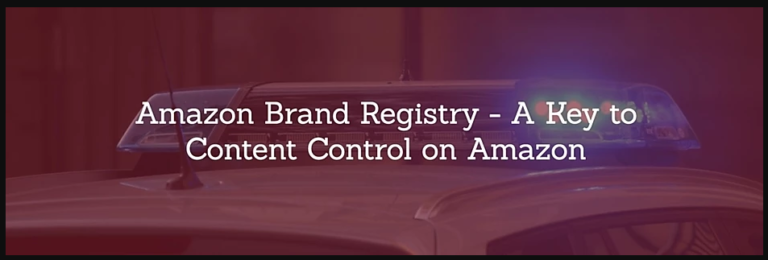Resources
Relevant Information and Actionable Takeaways

I have yet to meet with a brand owner that didn’t want to increase their sales on the Amazon marketplace. However, most often, there are two main challenges that stand between them and their goals:
1. A lack of the specialized knowledge required to effectively leverage Amazon’s marketing tools
2. It can be very difficult to identify and remove the unauthorized grey-market sellers that are causing MAP violations and a myriad of other problems for the brand
In today’s post, I’m going to start by walking you through some specific strategies that have been proven to work to increase sales on Amazon.
Then at the end, I want to finish off by ensuring that you have a clear understanding of just how dominant the Amazon marketplace has become in terms of consumer search patterns, and the impact of Amazon on your offline channels.
6 Tips for Increasing Sales on Amazon
1. Study Your Competition
Amazon is an extremely competitive marketplace. If your goal is to increase Amazon sales, the first step of the process is knowing what you are up against. With that, you’ll also want to consider the size of the opportunity (i.e., how many sales are there to be had?).
For example, if you sell horny goat weed, you would want to know the answers to the following questions:
1. Does my product have a unique ingredient or feature that sets it apart?
2. How many more reviews do the products in the organic search results have than mine?
3. How does the average product feedback rating of the competition compare to mine?
4. Are there a lot of ads from the competition?
5. How does my price (and value) compare to the competition?
6. What is the size of the market opportunity for the keywords that consumers would use to find my product?
As you can see below, I have done a search on Amazon for “horny goat weed.” In the red section, there is a headline search ad, in the blue section, there are a few sponsored product listings, and in the green section are the start of the organic search results.
In looking at this data, I can draw the following two conclusions:
1. My competitors are indeed running ads (though I don’t yet know the cost of these ads)
2. The top 2 organic search results have a very large number of reviews with an average of 4.5 stars

So, assuming you have a comparable product, you are going to need to either spend heavily on Amazon ads (possibly at a loss) or find another way to gain visibility on this channel.
Would it be worth the ad spend investment, considering the outcome is not guaranteed?
To find that out, I want to gain a better understanding of how much the phrase “horny goat weed” is worth in terms of sales.
As you can see below, the top 2 sellers combined generate approximately $244,000/mo in revenue. The aggregate revenue estimation from the remaining products on the first page of the search results is another $300,000/mo.
Armed with this data, you are now in a better position to determine if this is a battle you want to fight.

2. Optimize & Protect Your Content
Assuming this is a battle that you deem worthwhile, the first step should be to optimize your product listing content.
Optimizing content involves making sure you have:
- A product title that targets the correct keywords
- Product images that are more than just basic product shots
- Bullets that include features as well as benefits (see image below for example)
- A product description that makes use of Enhanced Brand Content

Once you have optimized your content, you also need to protect it to ensure that some other seller doesn’t decide to change it.
Key Take Away
PROPERLY OPTIMIZED PRODUCT LISTINGS CAN HAVE A PROFOUND EFFECT ON THE PRODUCT DETAIL PAGE CONVERSION RATE, WHICH IN TURN WILL HAVE A PROFOUND EFFECT ON HOW WELL THAT PRODUCT RANKS IN THE AMAZON ORGANIC SEARCH RESULTS.
3. Manage Your Product Reviews
If you want to succeed at increasing your sales on Amazon, pay close attention to your product reviews. When you do, you will find a few interesting things:
1. Some of your positive reviews will provide you with valuable customer feedback that you can use to improve the way your products are marketed, the keywords you should target etc.
2. Some of your negative product reviews will actually violate Amazon’s Terms of Service and could be easily removed
4. Advertise Your Products on Amazon
Over the years, Amazon has become an increasingly pay-to-play marketplace. Gone are the days when you could just list your product and watch the sales come in.To be successful today, you need to take advantage all of the advertising tools that Amazon provides to sellers. These tools include:
1. Headline search ads
2. Product placement ads
3. Sponsored product ads
4. Amazon Demand Side Platform
The above tools each have their pros and cons and if you want to increase your sales on Amazon profitably, you are going to need to make use of every tool in the toolbox. Expect to do plenty of testing with Amazon’s various advertising tools to get this right.
5. Drive Traffic To Your Products From Outside of Amazon
Amazon’s marketplace tools provide sellers with plenty of ways to buy additional exposure for their products; however, Amazon’s tools are far from the only tools available to sellers.
As you might imagine, the number of ways you can drive traffic to your Amazon product listings from external sources is virtually limitless – and well beyond the scope of this post.
What I will say is this: while Amazon doesn’t share the specifics of their search ranking algorithm, one thing that has been readily proven is that one of the greatest factors in organic search rank is sales velocity.
Key Take Away
SELLERS THAT HAVE ACCESS TO EXTERNAL TRAFFIC SOURCES WOULD BE WISE TO CONSIDER SENDING THAT TRAFFIC TO THEIR AMAZON PRODUCT LISTS SO THAT THEY CAN TAKE ADVANTAGE OF THE ‘FLYWHEEL EFFECT’ THAT AMAZON OFFERS.
In other words, more transactions = higher ranking in the organic search results, which in turn = more exposure for your products, which in turn = more sales.
In other words, the flywheel effect.
Key Take Away
MORE SALES = IMPROVED BEST SELLER RANK = IMPROVED POSITIONING IN AMAZON’S ORGANIC SEARCH RESULTS = MORE PRODUCT EXPOSURE TO AMAZON’S HUGE POOL OF BUYERS = MORE SALES
Amazon is an extremely popular marketplace with millions of eager buyers, so it behooves the smart brand owner to do everything they can to put their products in front of those buyers. Driving external traffic to Amazon with the sole purpose of improving BSR can yield substantial results in this regard.
6. Reduce the Number of Sellers to Just Two
Whenever I talk to brands that sell their products on the Amazon marketplace, they are often surprised to learn that having more sellers on each product listing is a bad thing. Many mistakenly assume that having more sellers will somehow increase exposure – and therefore increase sales.
Nothing could be further from the truth.
When you have one or two sellers on your product listings – assuming of course these sellers are working closely with you – your brand will experience the following benefits:
- A larger percentage of the seller’s profits can be invested in ad campaigns
- MAP violations will be eliminated entirely
- Your listings will be fully optimized
- Content will remain locked down
- All negative reviews in violation of Amazon TOS will be removed
So, now that you understand how to improve your product’s Amazon organic search rank (and sales), let me close out by ensuring you understand just how important Amazon has become for product research.
How Consumers Research Products Today
Check out the image below. This is data direct from Amazon.
As you can see, 59% of consumer research now starts on Amazon. But you probably knew that already.
What might be new to you is just how profound an impact Amazon is having on your offline sales.
Consider the following:
- 37% of searches start on Amazon and finish offline
- 22% of searches start in the aisle at a store where the buyer visits Amazon on their phone before completing the checkout in-store.
- 35% of searches start elsewhere and finish on Amazon
- Just 6% of searches start and finish on Amazon

Amazon Has a Greater Impact on Offline Sales Than You Might Think
The image above clearly tells us that Amazon has a much larger impact on offline sales than most brands think.
How do I know? I give presentations about Amazon to brands on a regular basis (every week) and whenever this slide comes up, the people I’m presenting to are very surprised by the data.
So, now that we know how much of impact Amazon is having on your total sales (not just online sales), what conclusions can we draw?
MAP Violations are a HUGE Deal: if keeping your offline retail partners happy is important to your business, you have to get online pricing under control (yes, this is possible). If you don’t, those offline retail partners are likely to remove your products from their shelves.
Controlling Product Content is Critical: Amazon product listings are much like a wiki. Unless you lock them down with Amazon’s Brand Registry, anyone can make any change at any time – which makes keeping your content under control virtually impossible. If you have products with FDA compliance issues, unauthorized content can even bring your listings down and wreak havoc on your revenue.
Responding to Negative Reviews is Critical: As I mentioned above, consumers today actively use Amazon for product research. Product reviews, in particular, play a huge role in their purchase decisions. If you (or your authorized 3rd party sellers) aren’t actively monitoring and responding to critical product reviews, you are definitely leaving money on the table.
Actions You Can Take Today
Whenever I give a presentation to a brand’s leadership team, at the end, I’m always asked something along the lines of, “What steps can we take today to solve our problems on Amazon?”
My answer is this:
- Reduce the number of sellers on your products listings to a chosen few, as doing so will have numerous benefits
- Choose to work with 3rd party sellers that do more than just sell your products
- If you are selling directly to Amazon, consider working with a 3rd party seller instead as you will have far more control



